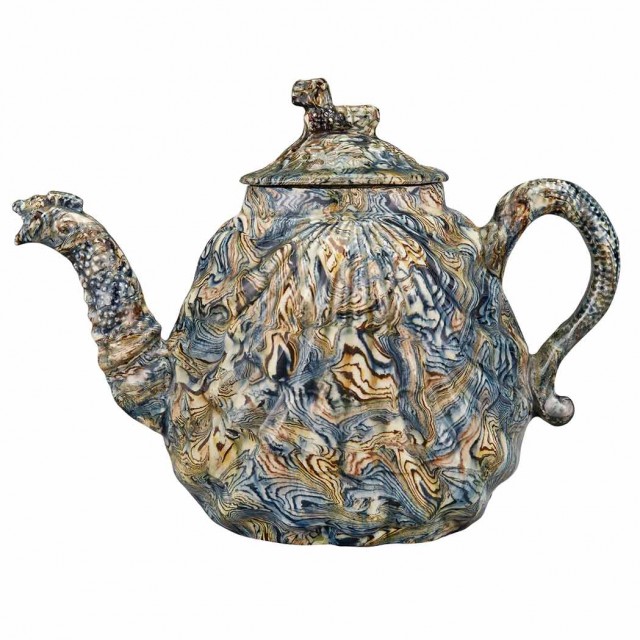English Agateware
01/12/2017 Furniture & Decorative Arts

The study of ceramics offers many opportunities to explore the nexus of history, technology and aesthetics. What were these objects used for and how were they made, what influenced their design? For connoisseurs of English pottery, some of the most satisfying wares to study and to own are agatewares.
In English pottery, this term refers to items with a multicolored striated patterning in imitation of exotic hardstones and marble, wherein the pattern is made in the clay body and not just on the surface as in marbled wares. Marbled wares are made by using colored slips (thinned clays) on the surface of a plain body. Agatewares (or solid agate) were made by layering up to four different clays colored with metallic oxides.
In a laborious hand process, the stacked layers would be thinned out, sliced and stacked again numerous times to refine the agate patterning. Smaller sections of this would then be rolled into “logs” and assembled together to form a block with an even more complex pattern. Then strips were cut from the block and rearranged into single sheets or bats with an even more fine-tuned and natural appearance.
To form objects such as teapots and cream jugs, the bat was carefully pressed into a plaster or clay mold being careful not to smear or break the intricate pattern. The main body was made in two halves with the spout, knop and feet being molded separately and assembled. Then the whole piece was coated with a lead glaze and refired. The bluish tint of many agateware is due to the glaze being stained by the cobalt oxide in one of the original clay layers.
Alternatively, the block of agate clay could be thrown on a wheel to form bowls and mugs, for example. Thrown agateware would have a muddied appearance from the hand-raising when they came off the wheel. After drying, the piece would be turned on a lathe to reveal the crisp patterning beneath the smeared surface.
Various refinements were introduced to the production of Staffordshire agate ware in the first half of the 18th century. Josiah Wedgwood, in partnership with Thomas Whieldon after 1754, wrote in his experiment book on March 23, 1759, “I had already made an imitation of Agat which was esteem’d very beautiful and a considerable improvement…” 1 Solid agateware was really a phenomenon of a few decades up until about 1760. Later, Josiah Wedgwood continued using the technique in neoclassical forms and used the technique to make ornamentation applied to other bodies.
As seen in the sauce boats and salvers included in the January 25, 2017 auction, the forms were often based on George II silver precedents, which give us a good handle on dating the pottery.
The production of Staffordshire agateware in the 18th century was probably influenced by early Chinese ware in English gentleman-connoisseurs’ collections. And certainly the Renaissance tradition of exhibiting rarities from around the world in a cabinet of curiosities, which included raw minerals and polished hardstones, must have been an inspiration to the rapidly developing pottery industry in the region.
Today, we can admire these examples of solid agateware as true gems of the potter’s art, combining pattern (which appeals to the modern eye), with form and technology in beautiful small-scale useful objects. Their aesthetic appeal and stimulating backstory make these tea and table wares the perfect choice for the contemporary connoisseur.
Property of a New Jersey Collector
In 2016, Doyle was honored to offer important American furniture and English silver from the Property of a New Jersey Collector. In the January 25, 2017 auction, we are pleased to offer 50 lots of early English pottery consigned by the same collector. Agateware in the collection comprises lots 573 through 584.
__________________________________
1 Michelle Erickson and Robert Hunter, Swirls and Whirls: English Agateware Technology. Chipstone, Ceramics in America, 2003